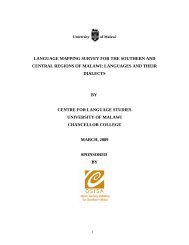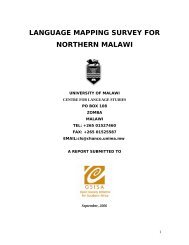SOCIOLOLINGUISTIC SURVEYS - Centre for Language Studies
SOCIOLOLINGUISTIC SURVEYS - Centre for Language Studies
SOCIOLOLINGUISTIC SURVEYS - Centre for Language Studies
Create successful ePaper yourself
Turn your PDF publications into a flip-book with our unique Google optimized e-Paper software.
Table 13:<br />
District<br />
Acceptance Of Chitumbuka As A Subject<br />
And As A Medium Of Instruction<br />
% Respondents<br />
Subject Medium of Instruction<br />
Yes No Yes No<br />
Chitipa 58.8 41.2 64.7 35.3<br />
Rumphi 75.0 25.0 75.0 25.0<br />
Karonga 75.0 25.0 75.0 25.0<br />
Mzimba 75.0 25.0 65.3 34.7<br />
Nkhata Bay 72.0 25.0 64.0 36.0<br />
From Table 13 It is clear that most of the teachers in all the five districts would accept<br />
Chitumbuka both as a subject and as a medium of instruction. The rather low percentage<br />
in Chitipa may be due to the fact that the district is not a typically Chitumbuka speaking<br />
one, and that there are several contending languages in the area such as Chilambia,<br />
Chisukwa and Chindali which are also widely spoken.<br />
A follow up question asked the teachers whether or not they are prepared to teach in<br />
Chitumbuka. The results are summarised in the Table 14 below<br />
TABLE 14:<br />
Preparedness To Teach In Chitumbuka<br />
District<br />
Yes<br />
% Respondents<br />
Chitipa 64.7 35.3<br />
Karonga 87.5 12.5<br />
Rumphi 87.5 12.5<br />
Mzimba 76.4 23.6<br />
Nkhata Bay 64.0 36.0<br />
No<br />
According to Table 14, teachers in all the districts of the region are prepared to teach in<br />
Chitumbuka.<br />
A corollary question sought to find out about what language the teachers were trained to<br />
teach in. The results are shown in Table 15<br />
33





